Roughly 80% of the population will experience back pain at some point in their life. That makes the chances high that either you’ve experienced back pain before or know someone who has. No wonder it’s common to hear the phrase, “My back hurts.”
Most people aren’t too sure what causes their back pain, some don’t even notice their back hurts until they’ve stopped moving, that’s because there’s a variety of causes for pain.
Pain can occur in the thoracic (upper), middle, or lumbar (lower) back. Some of the common causes of back pain are muscle straining, poor posture, herniated discs, scoliosis, compressed nerves, etc.
You may have noticed that some of the common causes of back pain are caused by the way you treat your body and others are factors you can’t control. Because of that, pain can either be temporary or chronic, both can interfere with daily activities and even health. Luckily, there are several ways to alleviate back pain from home as it’s often the last resort to see a medical professional.
Five Ways to Alleviate Back Pain
1. Fix Your Posture
Whether you’re standing or sitting (like most of us are nowadays) it’s important to remember proper posture. By having proper posture stress is prevented from being pressed on the spine and back muscles will improve. One way to do this is to get up and walk every hour, doing this will take a load of pressure off your discs.
2. Wake Up and Stretch
Stretching can prevent pain from occurring or prevent it from getting any worse. An ideal time to stretch is right when you wake up, that way the body is loose and ready to perform the rest of your daily activities. Here are two key stretches for the back:
- Figure 4 Stretch: This stretch targets the hips, lower back, and glutes. To perform this stretch, lie on your back with both feet flat on the ground and knees bent. Place one ankle over the opposite knee, reach through to grab the back of the leg that’s on the ground, and pull it toward your chest. Hold, then repeat with the other leg.
- Knee to Chest: This stretch targets the lower back and can lengthen the lower back. To perform this stretch, lie on your back with both legs flat on the ground. Raise one knee towards your chest, using both hands, clasp both hands under the knee, and place pressure gently to bring the knee closer to the chest. Hold, then repeat with the other leg.
3. Get a Massage
Ever wanted the chance to treat yourself? If you’re having body pain then consider a massage. Or even better, save money and try foam rolling. There are several types of foam rollers to choose from but if you’re just starting, choose one that is on the softer side. Remember, never foam roll directly on the area you’re trying to massage, you don’t want to irritate it more.

4. Achieve an Activity Goal
It may seem counterproductive to get active while in pain but sometimes moving is just the thing you need, especially if the pain comes and goes. Physical activity builds strong and flexible muscles that are less prone to injury. The workout doesn’t have to be extreme, something low impact like brisk walking, swimming, or cycling works well to prevent further inflammation or pain.
5. Try to Stress Less
It’s no secret that stress affects the body. Incorporating breathing exercises can relax the body and allow for muscles to loosen up which may reduce pain. Quality sleep also makes a difference which is possible when there’s less stress in the mind and body. When sleeping, place a pillow under you to elevate your legs to support a more neutral spine or put the pillow between your legs if you sleep on your side.

Though the back is an important part of the body, it’s also the most neglected. Luckily one of these ways may be able to help you alleviate back pain. But if the pain doesn’t go away, seek help from a medical professional or take a trip to your local chiropractor so you can get back to business.
Read On!!
If you enjoyed reading this article, continue reading to learn about 10 Proven Tips For Joint Pains Over the Age of 50 and don’t forget to subscribe!





